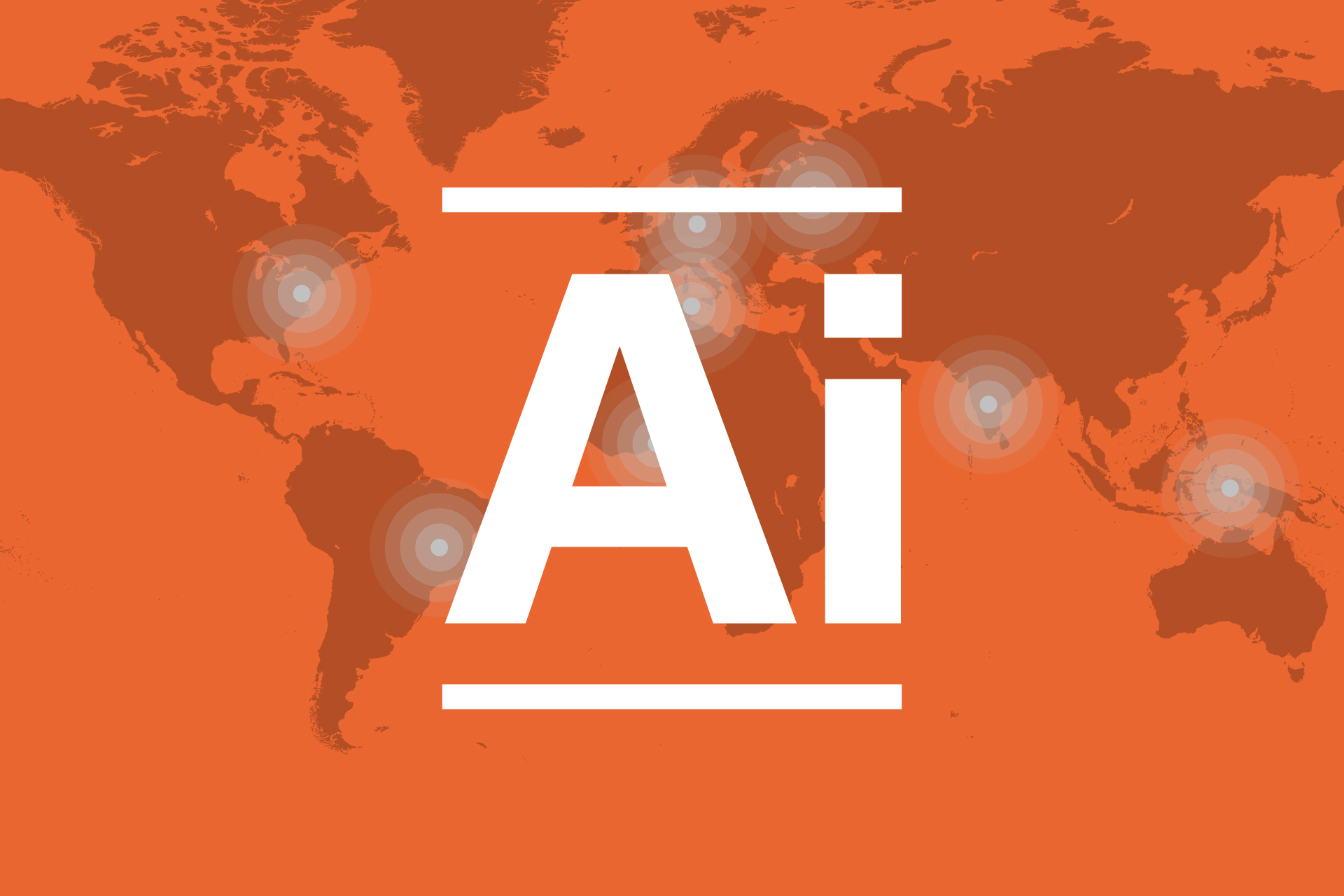Issue: 1/2025
From the air, Lake Chad in Central Africa looks like a mere puddle, and it has indeed shrunk dramatically compared to its size in the 1960s. Situated on the southern edge of the Sahara, the lake once used to sustain 20 million people through farming, fishing and trade. Today, more than ten million people living around the lake rely on humanitarian aid in order to survive as insecurity, shrinking fishing grounds and the effects of climate change take their toll. Nearly three million have fled their villages: Driven by desperation, many end up joining the jihadists. The United Nations describes this situation as one of the world’s largest humanitarian disasters, yet it barely makes headlines anymore, being overshadowed by crises in Ukraine, Syria and Israel/Gaza.
Compared to satellite images from 1960, it is barely possible to recognise Lake Chad, which was once the world’s sixth-largest lake. Today, it resembles a Norwegian fjord landscape, with countless small streams and islands providing perfect hiding spots for fighters from jihadist groups such as Boko Haram and the so-called Islamic State. Only at its southernmost tip does a larger, continuous body of water remain. Experts from the United Nations and the World Bank estimate that the lake shrunk by 90 per cent – that is, from 25,000 square kilometres in 1963 to just 1,500 square kilometres in 2001. However, increased rainfall on its two main tributaries has allowed the water level of Lake Chad to recover somewhat in recent decades. Estimates vary, with one putting the current surface at 14,000 square kilometres, though even this relatively high estimate is still far below the lake’s extension in the 1960s. Moreover, scientists disagree as to the exact changes in the lake’s surface area and the extent to which climate change is responsible.
The main obstacle to arriving at any accurate assessment is that the lake region is barely accessible to researchers due to the tense security situation. Even locals face the daily risk of abduction by jihadists and bandits. What is clear, however, is that water levels have declined over the long term and that climate change is, in general, taking a heavy toll on the region. Indeed, storms, floods and droughts alternate unpredictably, thereby making weather forecasts and planning nearly impossible, as the author was told by local farmers, fishermen, other villagers and NGO workers on a visit to the Chadian side of the lake in July 2024. Lake dwellers are catching fewer fish, and their farmland is yielding fewer crops. In some areas, locals are unable to fish or cultivate their fields at all due to the presence of jihadists from Nigeria. Many end up joining the jihadists simply in order to survive.
What is indisputable is that the lake region, which is home to more than 17 million people, has been caught up in a security crisis for over a decade, with jihadists of Boko Haram and the so-called Islamic State effectively controlling large parts of the area. The four countries bordering the lake – Chad, Niger, Nigeria and Cameroon – have only a weak state presence in the region, much like elsewhere in the Sahel. In Baga Sola, a small town on the Chadian side of the lake, there are no paved roads outside the capital, and electricity is scarce. The four lake-bordering countries coordinate through a commission to improve water management, but apart from being heavily reliant on foreign funding, this coordination is largely inefficient: Indeed, in many cases, state authority is too weak to implement the commission’s decisions.
Mismanagement and Climate Change
How did the crisis unfold? Firstly, there has been a decline in the lake’s water levels compared with in the 1960s. Some researchers attribute this decline to overuse and poor management of the lake and its tributaries in the past. While the lake’s water levels now appear more stable, scientists view climate change in general as the greater issue, with increasingly extreme and unpredictable weather patterns affecting the region. Chad, Niger and northern Nigeria have endured years of torrential rainfalls, which have resulted in devastating floods. At the same time, the region regularly experiences prolonged droughts with no rainfall and temperatures that are increasing at roughly one and a half times the global average. In Chad, for instance, temperatures could rise by between 2.1 and 4.3 degrees by 2080: Thus, the growing weather instability will render it ever more difficult for farmers to cultivate their fields or to plan for the future.
The lack of rainfall also means that the Sahara Desert is spreading farther south into the Sahel. Where farming is still possible, crop yields are declining. Paradoxically, Chad and Niger also suffer from severe flooding, with entire villages and even towns having been devastated in 2024: In the city of Zinder in Niger, large parts of the old town were heavily damaged, and even the minaret of the main mosque was destroyed. Thus, there is either too little rain in the region or far too much.
What is more, all four lake-bordering countries struggle with widespread poverty and rapidly growing populations. In Niger, women give birth to an average of seven children, while Nigeria’s population is expected to reach up to 400 million by 2050 according to the United Nations – almost double today’s figure. Chad and Niger are among the poorest countries in the world, regularly ranking among the bottom ten on a UN index comparing global living standards. Outside the capital cities, state authority is weak and barely present. Cameroon is slightly better off, but with a ranking of 151 out of the 191 total countries in the UN index, it still falls in the lower quarter. Moreover, while Nigeria is Africa’s largest oil producer, its oil wealth benefits only a small fraction of the population.
Jihadists on the Rise
Alongside many losers, there are also winners at Lake Chad: Boko Haram and the so-called Islamic State have benefited from shifting water levels and extreme weather fluctuations ranging from drought to torrential rain, which make farming more difficult and strip many people of their livelihoods. According to the US military, climate change in the lake region is exacerbating the threat posed by jihadists.
Where did the jihadists come from? The group Boko Haram launched an uprising in northern Nigeria in 2009, accusing the country’s elites of corruption and mismanagement. Northern Nigeria is significantly poorer than the oil-rich south, which is home to the economic hub of Lagos. Many people once found jobs in the textile industry in the north of the country, but decades of mismanagement and cheap imports from China and Europe have led to its decline. Boko Haram claims that Nigeria’s elites have sold out the values of the Muslim north to the West – the name “Boko Haram” can roughly be translated as “Western schools are forbidden”. Rejecting Western education, the group aims to Islamize society and has increasingly become a rallying point for the impoverished masses.
Fig. 1: Extent of Lake Chad: 1963 and 2024
From northern Nigeria, Boko Haram expanded across the borders into Niger, Cameroon and Chad. A leadership struggle split the group in 2016, with numerous fighters joining an offshoot of the so-called Islamic State that operates with even greater brutality. Since then, the two factions have been fighting each other for control over territory. For years, the four lake-bordering countries have attempted to combat the jihadists with cross-border military operations, albeit with little success.
Changing water levels and climate shifts around Lake Chad have been a boon for Boko Haram and the so-called Islamic State. Driven by insecurity and unpredictable weather, rising poverty is pushing more and more unemployed fishermen and farmers into the ranks of radical fighters, while even more crucially, the newly formed islands have become a perfect hideout for these jihadist groups. They control the islands in the lake’s interior, where they have set up camps, weapons depots and shelters for their fighters. From there, they spread terror along the shores. Moving in boats, they raid villages and attack fishermen, forcing them to collaborate. Time and again, jihadists kill or abduct village elders in order to seize power themselves.
The fragility of the situation was evident during a visit by the author to a village on the Chadian side of the lake: Fishermen there venture no more than one or two kilometres into the lake’s shallow waters. “If we go too far, Boko Haram forces us to hand over our catch”, said Toh Moussa, head of a local fishermen’s association. “Only the waters close to the shore are safe.” Other fishermen brought their catch to shore as he spoke, though the haul amounted to only small and juvenile fish – the kind that thrive in the shallow waters near the village. The fisherman would have to venture farther out to catch larger fish, but that would be far too dangerous.
Intervention Force Faces an Uncertain Future
With the support of Western nations, the four lake-bordering countries of Nigeria, Chad, Niger and Cameroon have established an intervention force – the so-called Multinational Joint Task Force – for conducting cross-border operations against the jihadists. This task force has received guidance from around 10 to 20 soldiers from France, the United States and the United Kingdom to date along with tactical intelligence on jihadist movements. However, the future of this Western support is uncertain. The Trump administration is unlikely to show much interest in Africa, and Chad has just ended its military cooperation with France. This is not the only setback, though, as Niger has also significantly reduced its cooperation with the task force following a military coup in 2023.
Even under normal circumstances, the intervention force has not been particularly effective. The task force conducts air strikes against the jihadists, but its soldiers are unable to seize the militants’ strongholds on the islands because the fighters quickly escape to other islands in small wooden boats known as pirogues. In the narrow tributaries, which are often only a few metres wide, the intervention force frequently falls into ambushes. Since the jihadists are able to retreat to other difficult-to-reach hideouts within the lake region, ground operations only achieve limited success. Particularly during the rainy season from May to September, when water levels rise and new waterways emerge, the fighters are extremely agile on the water.
Even the lakeside villages are not safe. “Boko Haram has eyes and ears everywhere”, said an NGO worker during the author’s visit to the lake: “We don’t know which people in the village are working for Boko Haram and passing on information.” After about fifteen minutes, a crowd began to gather on the shore, and the NGO worker urged the author to leave. The four-nation task force maintains a base not far away, but it often arrives too late when attacks occur. There are no reliable data on the number of attacks carried out. As an example for insecurity, an internal report compiled by diplomats at the end of May 2024 documents more than ten jihadist attacks in the lake region, some of them in the administrative district of Baga Sola, where the United Nations operates a regional hub for humanitarian aid deliveries. More than twenty people were abducted, over one dozen killed, and several cases of livestock theft were also reported.
Nevertheless, given the many ongoing crises worldwide, the situation around Lake Chad has been deemed too insignificant for international media to cover. Overall, however, the attacks indicate that the jihadists have effectively taken control of the lake region. They have even launched larger-scale operations, such as in October 2024, when dozens of Chadian soldiers were killed in an attack on a military barracks. Questioning the effectiveness of the four-nation task force, Chad’s president Mahamat Déby reacted with anger: Just days later, he even ordered the withdrawal of French troops, who had been stationed in Chad since the country’s independence in 1960. Déby had allegedly urged France to launch air strikes against Boko Haram, but his efforts proved unsuccessful.
Many residents in the lake region would be unlikely to miss the task force. While the soldiers manage to keep the jihadists somewhat in check through their operations, they also fuel the conflict themselves by committing abuses against civilians. According to a study funded by the German Foreign Office and the Netherlands, in addition to jihadist attacks, lake-area residents also complain about military exclusion zones, where fishing is prohibited. While the military seeks to prevent jihadists from benefiting from fishing, they in fact deprive people of their livelihoods, thereby making them even more vulnerable to recruitment by the jihadists. There are also reports of abuses by soldiers, who suspect civilians of collaborating with the jihadists, confiscate fishermen’s catches and demand sex in exchange for food from women: “A large number of affected respondents […] cited security forces’ harassment and the community’s mistrust and frustration with security measures as reasons for re-joining armed opposition groups”, the study states.
Nigeria – The Main Problem
The Chadian side of the lake is relatively safe – at least, it is safe enough for the United Nations to coordinate humanitarian operations from the region. For years, this region has also served as a refuge for Nigerian civilians fleeing their villages in the wake of jihadist attacks. Not far from the UN logistics hub in Baga Sola, there is a refugee camp that from 2016 until recently housed more than 5,000 people from Nigeria. Most of these refugees came from Baga, a small town on the Nigerian side of the lake that – along with its surrounding region – has become a jihadist stronghold. Camp residents have repeatedly tried to return home, but without success. “It’s too dangerous because Boko Haram is still active there”, said Aachi Mai, a farmer from Baga who has made several attempts to return to his fields. Other refugees have reported that when they ventured farther out onto the lake to fish, jihadists forced them to hand over their catch.
In February 2025, Nigeria and Chad agreed that some refugees should return. The first camp residents have since left for Nigeria, but they have not returned to their old villages: Instead, they have been relocated to Maiduguri, the heavily militarised capital of Borno State in north-eastern Nigeria. The Nigerian army has not been able to defeat the jihadists in Borno’s rural areas, where the insurgency began in 2009. Maiduguri is now safer than it was a few years ago and has become a refuge for 300,000 people (mostly farmers who have fled from the jihadists), but very few dare to return home.
Nigeria remains the main area in which Boko Haram and the so-called Islamic State operate: Their fighters find refuge along the lake’s shores and in the remote Sambisa Forest. The Nigerian army has repeatedly faced criticism for human rights violations in its fight against the jihadists. However, the biggest issue remains the weak presence of the Nigerian state in Borno outside of Maiduguri and the immediate lake region. Wherever authorities fail to establish public services and to provide people with a future, military operations against jihadists remain ineffective, which is also why various military interventions have been unsuccessful, whether by France or in the case of the current Russian involvement in Sahel countries, such as Mali.
Lake Chad has receded the farthest on the Nigerian side, where there is no longer access to the remaining open water. In its place lies only a landscape of swamps, small bodies of water and islands – ideal terrain for jihadists, who are highly mobile. Neither the Nigerian army nor the four-nation task force can control this remote area, for the region has become like hostile territory to them. The jihadists force the local population to collaborate, gathering intelligence on army movements, while soldiers often take out their anger on civilians in retaliation. This situation has further deepened resentment towards a state that provides no services such as schools or healthcare and that is known primarily for corruption and military abuses – a vicious cycle with no apparent way out.
– translated from German –
Ulf Laessing is Director of the Konrad-Adenauer-Stiftung’s Sahel Regional Programme based in Bamako.
Choose PDF format for the full version of this article including references.






